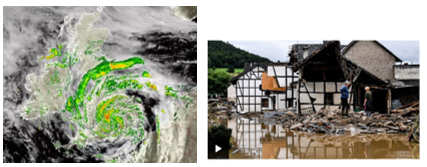Lead Supervisor: Len Shaffrey, National Centre for Atmospheric Science (NCAS) and Department of Meteorology, University of Reading
Email: l.c.shaffrey@reading.ac.uk
Co-supervisors: Ben Harvey, National Centre for Atmospheric Science (NCAS) and Department of Meteorology, University of Reading; Alison Kay, UK Centre for Ecology and Hydrology; Rob Lamb, JBA Trust
Summertime precipitation extremes are increasing in Europe due to climate change. The record-breaking rainfall that fell in July 2021 provides one devastating example. This was caused by a slow-moving cut-off low pressure system moving across the UK, Belgium, and northern Germany. The associated convective thunderstorms caused widespread flooding and lead to substantial damage and loss of life. The formation of such cut-off lows is a complex nonlinear process resulting from the breaking of large-scale meanders of the jet stream over the North Atlantic. Warming temperatures provide a direct thermodynamic influence on these systems (greater moisture availability enhances latent heat release, supercharging the strength of embedded convective systems) but the extent to which climate change will also modify the larger-scale dynamics of the jet stream and what that will mean for the formation and evolution of cut-off lows remains an open question, posing a substantial uncertainty to assessments of future flood risk.

LEFT: A satellite image of the July 2021 cut-off low pressure system which went on to cause extensive flooding in the Belgium and northern Germany. RIGHT: Some of the damage caused.
This project will investigate interactions between future changes in the summertime North Atlantic jet stream, cut-off low weather systems, and their associated flooding impacts. The North Atlantic jet stream is the dominant driver of atmospheric circulation over the UK and NW Europe and variability of the jet stream directly drives variability in European weather. On daily timescales, individual weather systems are steered by and draw energy from the jet, and on longer timescales variations in the mean position and strength of the jet are highly correlated with seasonal precipitation and temperature anomalies in European climate. One robust feature emerging from future climate projections is a northward shift of the mean summertime North Atlantic jet, away from the UK. In the future, UK summers are consistently projected to become dryer, on average. But this poses several questions related to cut-off lows and precipitation extremes: how will the projected northward shift of the jet modify the location and frequency of slow-moving cut-off low pressure systems? Will the weaker jet stream over the UK result in slower-moving cut-off lows, and therefore larger local rainfall totals? How will this influence flooding events in the UK and NW Europe?
This project will address these highly topical questions by utilizing two major new modelling activities being undertaken by the project supervisors as part of the multi-disciplinary CANARI program (www.canari.ac.uk). The first is a 40-member single model large-ensemble experiment (SMILE) aimed at characterizing climate risks to the UK associated with forced and internal variability over the coming decades. The second is a 300-member case study set of extreme storms impacting Europe, simulated at very high convection-permitting resolution over a large pan-European domain. Together with state-of-the-art hydrological simulations driven by their outputs, these provide an unprecedented opportunity to study the changing convective dynamics associated with cut-off lows, the large-scale conditions in which they form, and the resulting flood impacts.
Initial work will characterize future changes in the summertime North Atlantic jet changes in the SMILE (e.g. how robust is the northward shift among different members? do some members show particularly large and/or rapid shifts?) before employing feature tracking software to characterize the statistics of cut-off lows over Europe (e.g. what characteristics of cut-off lows are associated with the highest precipitation impacts? how are the geographic location, propagation speeds and associated precipitation of cut-off lows projected to change in future?). Combined, these analyses will allow a novel assessment of the links between future changes in the large-scale atmospheric circulation and changes in precipitation extremes. Subsequent work will follow the interests of the student but could explore flood risk in more detail, for example by quantifying the changing flood risks associated with cut-off lows using hydrological model outputs, or by creating event-based storylines of how the changing characteristics of cut-off lows will impact flood risk regionally. A further avenue could be to study the convective dynamics of the weather systems, utilizing novel diabatic tracer diagnostics in the convection-permitting simulations to understand the changing interaction between latent release and the large-scale environment.
Training Opportunities
The project is CASE supported by JBA Trust (www.jbatrust.org), and will include guidance from and a placement within JBA teams working on flood risk and impacts analysis, to explore applications of the research, translating hydrological expertise learnt into flood management and climate resilience implications.
In addition, the Flood Estimation Handbook (FEH) offer guidance on rainfall and river flood frequency estimation across the UK, required for performing flood risk assessments and flood defence planning. During the project the student will, under the advisement of the FEH Team at UKCEH (Dr Adam Griffin), undertake a study of these industry-standard methods.
Student Profile
The project would be suited to a student with a degree in a physical science. Prior knowledge of atmospheric and environmental science is desirable, but not essential. Some experience with computer programming and data analysis would be beneficial.
Funding Particulars
This project has CASE support from JBA Trust.

